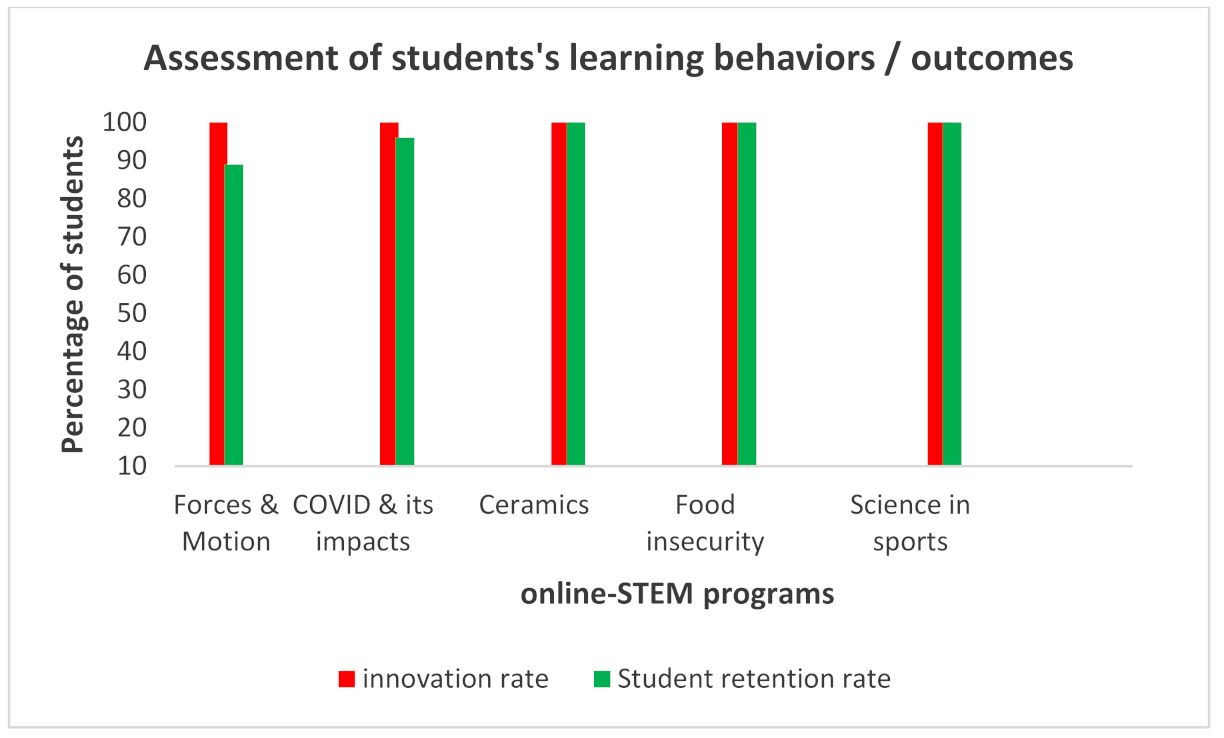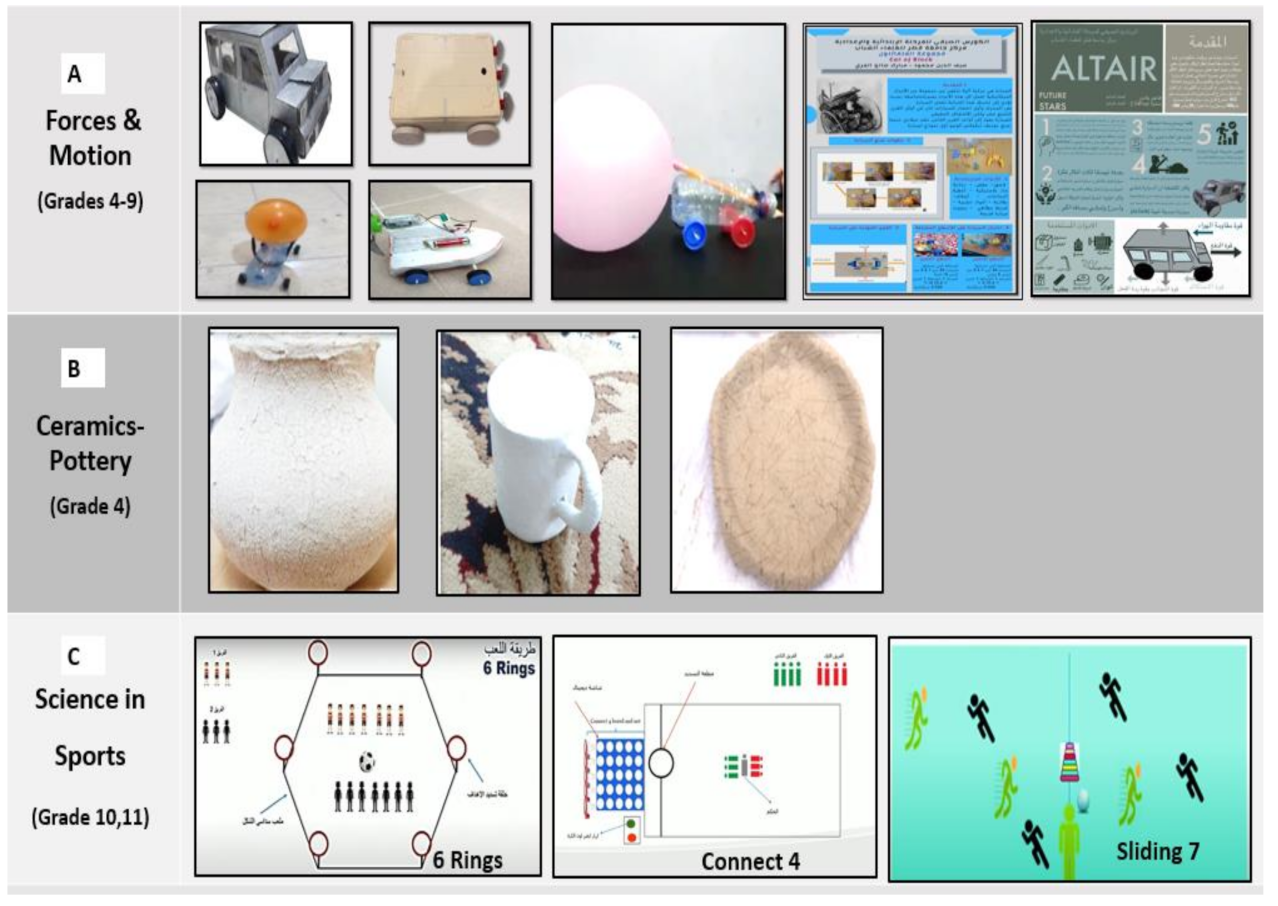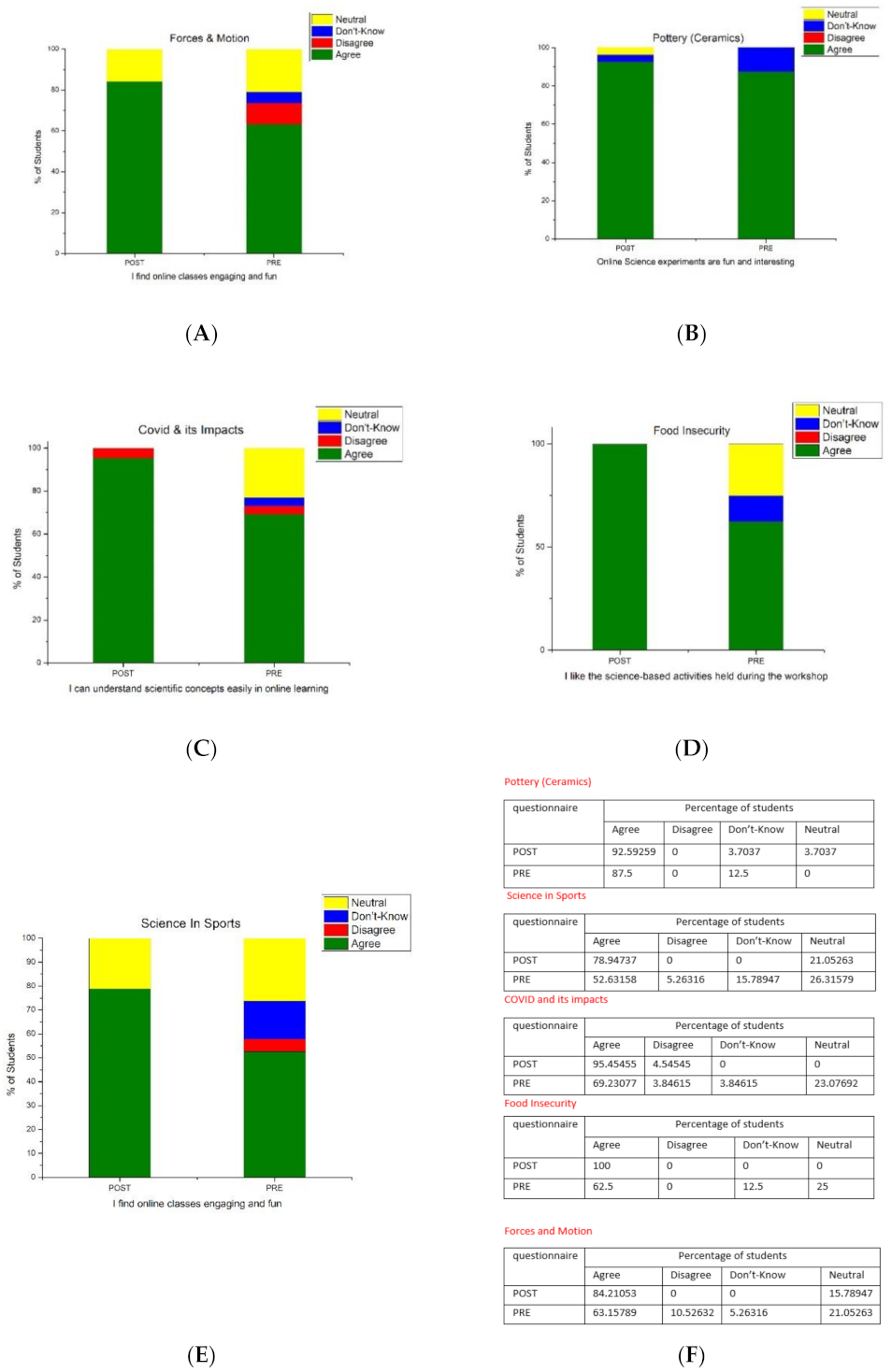A Distinctive Method of Online Interactive Learning in STEM Education
Abstract
1. Introduction
2. Materials and Methods
2.1. Research Questions
- Will the course design provide an adequate active virtual learning environment to improve students’ attitudes towards online education?
- Will the designed course be successfully implemented to attain its target objectives such as improved student interaction and creative peer collaboration?
- Will the course design provide scope for improvement and replication?
- Will the design offer course flexibility and applicability, especially under limited learning opportunities?
2.2. Course Particulars
2.2.1. Course Facilitators/Developers (Primary Mentors)
2.2.2. Course Participants
2.2.3. Undergraduate Students (Course Secondary Mentors)
2.2.4. Course Framework
2.2.5. Course Breakdown
2.2.6. Course Curriculum Standards
2.2.7. Digital Learning
2.2.8. Digital Learning Platform
2.2.9. Digital Learning Resources
2.2.10. Course Activities
2.2.11. Course Assessment
3. Results
3.1. Results
3.1.1. Assessment of Course Content and Design
3.1.2. Assessment of Student Learning Behavior/Outcomes
3.1.3. Upgradation of the Course Content for a Sustainable Educational Model
4. Discussion
Author Contributions
Funding
Institutional Review Board Statement
Informed Consent Statement
Data Availability Statement
Acknowledgments
Conflicts of Interest
Appendix A
- https://www.youtube.com/watch?v=sSm8MYUqNNk&list=PLJ5aYnwwtu-xMbruU-GKb2mO4i-DM5yI9&index=1, (accessed on 9 September 2021)
- https://www.youtube.com/watch?v=bbZWSD_-OmM&list=PLJ5aYnwwtu-xMbruU-GKb2mO4i-DM5yI9&index=2, (accessed on 9 September 2021)
- https://www.youtube.com/watch?v=VLhx2keYsmk&list=PLJ5aYnwwtu-xMbruU-GKb2mO4i-DM5yI9&index=3, (accessed on 9 September 2021)
- https://www.youtube.com/watch?v=KbnXAXBm8_8&list=PLJ5aYnwwtu-xMbruU-GKb2mO4i-DM5yI9&index=4, (accessed on 9 September 2021)
- https://www.youtube.com/watch?v=QljRSX96EhY&list=PLJ5aYnwwtu-xMbruU-GKb2mO4i-DM5yI9&index=5, (accessed on 9 September 2021)
- https://www.youtube.com/watch?v=8H6oPFhadpE, (accessed on 9 September 2021)
- https://www.youtube.com/watch?v=EUobZR2Wm9w, (accessed on 9 September 2021)
- https://www.youtube.com/watch?v=t9ERGbbL16s, (accessed on 9 September 2021)
- https://www.youtube.com/watch?v=XwNM0twEOBo, (accessed on 9 September 2021)
- https://www.youtube.com/watch?v=vpqxv71hADo, (accessed on 9 September 2021)
- https://www.youtube.com/watch?v=LLTs3jWHUvA, (accessed on 9 September 2021)
- https://www.youtube.com/watch?v=XiFHyJOgC3E, (accessed on 9 September 2021)
- https://www.youtube.com/watch?v=VgwunE7dzDU, (accessed on 9 September 2021)
- https://www.youtube.com/watch?v=jM9Uoq5ceXk, (accessed on 9 September 2021)
Appendix B


References
- Wang, C.; Cheng, Z.; Yue, X.G.; McAleer, M. Risk management of COVID-19 by universities in China. J. Risk Financ. Manag. 2020, 13, 36. [Google Scholar] [CrossRef]
- Simuț, C.; Petrila, L.; Popescu, F.A.; Oprea, I.M. Challenges and Opportunities for Telecommuting in the School System: Building a Sustainable Online Education in the Context of the SARS-Cov-2 Pandemic. Sustainability 2021, 13, 10296. [Google Scholar] [CrossRef]
- Adnan, M.; Anwar, K. Online Learning amid the COVID-19 Pandemic: Students’ Perspectives. Online Submiss. 2020, 2, 1309. [Google Scholar] [CrossRef]
- Yu, X.; Zhang, M.; Xue, Y.; Zhu, Z. An exploration of developing multi-touch virtual learning tools for young children. In Proceedings of the 2010 2nd International Conference on Education Technology and Computer, Shanghai, China, 22–24 June 2020; pp. V3-4–V3-7. [Google Scholar]
- Torres Martín, C.; Acal, C.; El Honrani, M.; Mingorance Estrada, Á.C. Impact on the Virtual Learning Environment Due to COVID-19. Sustainability 2021, 13, 582. [Google Scholar] [CrossRef]
- Barlow, A.; Brown, S. Correlations between modes of student cognitive engagement and instructional practices in undergraduate STEM courses. Int. J. Stem. Educ. 2020, 7, 1–15. [Google Scholar] [CrossRef]
- Mulqueeny, K.; Kostyuk, V.; Baker, R.S.; Ocumpaugh, J. Incorporating effective e-learning principles to improve student engagement in middle school mathematics. Int. J. Stem. Educ. 2015, 2, 1–14. [Google Scholar] [CrossRef][Green Version]
- Dixson, M.D. Creating effective student engagement in online courses: What do students find engaging? J. Scholarsh. Teach. Learn. 2010, 10, 1–13. [Google Scholar]
- Aderibigbe, S.A. Online Discussions as an Intervention for Strengthening Students’ Engagement in General Education. J. Open Innov. Technol. Mark. Complex. 2020, 6, 98. [Google Scholar] [CrossRef]
- Moore, M.G. Three Types of Interaction. Am. J. Distance Educ. 1989, 3, 1–7. [Google Scholar]
- Bernard, R.M.; Abrami, P.C.; Borokhovski, E.; Wade, C.A.; Tamim, R.M.; Surkes, M.A.; Bethel, E.C. A meta-analysis of three types of interaction treatments in distance education. Rev. Educ. Res. 2009, 79, 1243–1289. [Google Scholar] [CrossRef]
- Hege, B.A. The online theology classroom: Strategies for engaging a community of distance learners in a hybrid model of online education. Teach. Theol. Relig. 2011, 14, 13–20. [Google Scholar] [CrossRef]
- Luo, N.; Zhang, M.; Qi, D. Effects of different interactions on students’ sense of community in an e-learning environment. Comput. Educ. 2017, 115, 153–160. [Google Scholar] [CrossRef]
- Abrami, P.C.; Bernard, R.M.; Bures, E.M.; Borokhovski, E.; Tamim, R.M. Interaction in distance education and online learning: Using evidence and theory to improve practice. J. Comput. High. Educ. 2011, 23, 82–103. [Google Scholar] [CrossRef]
- Kehrwald, B. Understanding social presence in text-based online learning environments. Distance Educ. 2008, 29, 89–106. [Google Scholar] [CrossRef]
- Abouhashem, A.; Abdou, R.; Bhadra, J.; Siby, N.; Ahmad, Z.; Al-Thani, N. COVID-19 Inspired a STEM-Based Virtual Learning Model for Middle Schools—A Case Study of Qatar. Sustainability 2021, 13, 2799. [Google Scholar] [CrossRef]
- Cong, L.M. Successful Factors for Adoption of Synchronous Tools in Online Teaching at Scale. In Tertiary Education in a Time of Change; Springer: Singapore, 2020; pp. 39–60. [Google Scholar]
- Abaci, S.; Robertson, J.; Linklater, H.; McNeill, F. Supporting school teachers’ rapid engagement with online education. Educ. Technol. Res. Dev. 2020, 69, 29–34. [Google Scholar] [CrossRef] [PubMed]
- Dumford, A.D.; Miller, A.L. Online learning in higher education: Exploring advantages and disadvantages for engagement. J. Comput. High. Educ. 2018, 30, 452–465. [Google Scholar] [CrossRef]
- O’Donoghue, J. Stories from the Lab: Development and Feedback from an Online Education and Public Engagement Activity with Schools. J. Chem. Educ. 2020, 97, 3271–3277. [Google Scholar] [CrossRef]
- Catron, C.E.; Allen, J. Early Childhood Curriculum: A Creative Play Model; Prentice Hall: Upper Saddle River, NJ, USA, 2008. [Google Scholar]
- Singh, V.; Thurman, A. How many ways can we define online learning? A systematic literature review of definitions of online learning (1988–2018). Am. J. Distance Educ. 2019, 33, 289–306. [Google Scholar] [CrossRef]
- Martin, S.H. Environment-Behaviour Studies in the Classroom. J. Des. Technol. Educ. 2009, 9, 77–89. [Google Scholar]
- Jones, S.; Myhill, D. ‘Troublesome boys’ and ‘compliant girls’: Gender identity and perceptions of achievement and underachievement. Br. J. Sociol. Educ. 2004, 25, 547–561. [Google Scholar] [CrossRef]
- Choi, J.; Walters, A. Exploring the Impact of Small-group Synchronous Discourse Sessions in Online Math Learning. Online Learn. 2018, 22, 47–64. [Google Scholar] [CrossRef]
- Rennar-Potacco, D.; Orellana, A. Academically Supporting STEM Students from a Distance Through Videoconferencing: Lessons Learned. Am. J. Distance Educ. 2018, 32, 131–149. [Google Scholar] [CrossRef]
- Sun, D.; Looi, C.K. Designing a Web-Based Science Learning Environment for Model-Based Collaborative Inquiry. J. Sci. Educ. Technol. 2013, 22, 73–89. [Google Scholar] [CrossRef]
- Viegas, M.C.; Pavani, A.M.; Lima, N.; Marques, A.; Pozzo, M.I.; Dobboletta, E.; Atencia, V.; Barreto, D.; Calliari, F.; Fidalgo, A.V.; et al. Impact of a remote lab on teaching practices and student learning. Comput. Educ. 2018, 126, 201–216. [Google Scholar] [CrossRef]
- Vijayan, A.; Nutakki, C.; Kumar, D.; Achuthan, B.N.; Diwakar, S. Enabling a freely accessible open source remotely controlled robotic articulator with a neuro-Inspired control algorithm. Int. J. Online Eng. 2017, 13, 61–75. [Google Scholar] [CrossRef]
- Kobayashi, T.; Fukumura, Y.; Dharmawansa, A.; Ogawa, N.; Kanematsu, H.; Barry, D.M. “Virtual STEM Class for Nuclear Safety Education in Metaverse. Procedia Comput. Sci. 2014, 35, 1255–1261. [Google Scholar]
- Gilliam, M.; Jagoda, P.; Fabiyi, C.; Lyman, P.; Wilson, C.; Hill, B.; Bouris, A. Alternate Reality Games as an Informal Learning Tool for Generating STEM Engagement among Underrepresented Youth: A Qualitative Evaluation of the Source. J. Sci. Educ. Technol. 2017, 26, 295–308. [Google Scholar] [CrossRef]
- Mavridis, A.; Katmada, A.; Tsiatsos, T. Impact of online flexible games on students’ attitude towards mathematics. Educ. Technol. Res. Dev. 2017, 65, 1451–1470. [Google Scholar] [CrossRef]
- Hursen, C.; Bas, C. Use of Gamification Applications in Science Education. Int. J. Emerg. Technol. Learn. 2019, 14, 4. [Google Scholar] [CrossRef]
- Qatar University Young Scientists Center. Al-Bairaq. Available online: https://www.qu.edu.qa/research/ysc/al-bairaq-program (accessed on 9 September 2021).
- Sadler, P.M.; Sonnert, G.; Hazari, Z.; Tai, R. Stability and volatility of STEM career interest in high school: A gender study. Sci. Educ. 2012, 96, 411–427. [Google Scholar] [CrossRef]
- Åhslund, I.; Boström, L. Teachers’ Perceptions of Gender Differences: What about Boys and Girls in the Classroom? Int. J. Learn. Teach. Educ. Res. 2018, 17, 28–44. [Google Scholar] [CrossRef]





| Introduction session: | The introduction session was used to recollect the prior days’ STEM lessons and to discuss the submitted asynchronous assignments. The first day’s introduction session was different from the rest of the days. It was because the first day’s introduction session was to introduce participants to their teams and familiarize them with the entire batch of facilitators and mentors and, finally, to give them a glimpse of the online STEM program. |
| Scientific session: | The activities for the STEM course were both synchronous and asynchronous, and it was designed and modified according to the students’ feedback. The time allotted to stimulate students’ curiosity gradually dropped in the subsequent sessions, indicating that they were self-excited. The sole purpose of the scientific sessions was to help them acquire scientific knowledge through problem-solving and inquiry-based activities. Finally, the engineering design challenge activity was completed asynchronously with the help of UG mentors, parents, and facilitators. |
| Concluding session: | The concluding sessions consisted of the summary of the daily lessons, allocation of the assignments, detailing the requirements for the next day’s sessions, and the collection of student feedback. The feedback session was not limited by time, thereby giving them more convenience in expression. The allocation of assignments on the last day took more time, as the students were guided towards their design challenge detailing the design and evaluation criteria of the project/idea that they were supposed to come up with. |
| Activity 1 Stimulating students | Every day, the online sessions commenced with an ice-breaking activity. It helped the participants to reconnect and proceed with the topic with discussions. The activity also aided in igniting the students’ interest and encouraging them to participate actively throughout the session. In addition, this activity motivated them to complete the entire course without falling behind. |
| Activity 2 Inquiry-based learning | To assess their core competencies, students were enriched with research-intensive knowledge that supported them to demonstrate their research skills. It helped students to develop their scientific hunting and research skills. |
| Activity 3 Problem-solving and critical thinking | Students performed the technical experiments based on the lesson objectives. Wherein, several online simulations, virtual laboratories, and hands-on live sessions were used to enhance their problem-solving, design-thinking, and critical-thinking skills. |
| Activity 4 Creative imagination | Apart from engaging in hands-on activities, students mapped their learning experiences and the lesson outcomes using the interactive tools. |
| Product design challenge or innovative ideas and evaluations | The students were challenged on the last day to design a product or brainstorm an innovation based on the acquired knowledge. Finally, the students transformed the acquired information, knowledge, and skills from the previous sessions into the final output (product/idea). During the evaluation, each student’s group/student presented their final output in front of the judging panel through a web conference. The judging panel consisted of engineers from different streams of Qatar University, along with an outreach specialist from the (Ras Laffan Industrial City) oil and gas industry. The students’ output delivery was in the form of either MS PowerPoint presentations or poster presentations with a detailed explanation of their project/work/idea. |
| STEM Program | Grades | Cycles | Total Number of Students | Total Number of Research-Based Projects | UG Mentor Involved |
|---|---|---|---|---|---|
| Forces and motion | 4–9 | 1 | 38 | 15 | Yes |
| COVID-19 and its impacts | 10, 11 | 1 | 18 | 15 | Yes |
| Ceramics | 4 | 2 | 27 | 27 | No |
| Food insecurity | 4 | 1 | 16 | 16 | No |
| Science in sports | 10, 11 | 2 | 41 | 12 | No |
| STEM Program | Learning Tools/Approaches Used | Final Students’ Outcome (Product/Idea) | Project Outcome Rate | Student Retention Rate |
|---|---|---|---|---|
| Forces and motion |
| Working car model | 100% | 89% |
| COVID-19 and its impacts |
| The idea to prevent the spread of the pandemic | 100% | 96% |
| Ceramics |
| Crockery model with clay | 100% | 100% |
| Food insecurity |
| Greenhouse model for plants | 100% | 100% |
| Science in sports |
| Innovative gaming idea, incorporating sustainability aspect | 100% | 100% |
Publisher’s Note: MDPI stays neutral with regard to jurisdictional claims in published maps and institutional affiliations. |
© 2021 by the authors. Licensee MDPI, Basel, Switzerland. This article is an open access article distributed under the terms and conditions of the Creative Commons Attribution (CC BY) license (https://creativecommons.org/licenses/by/4.0/).
Share and Cite
Abouhashem, A.; Abdou, R.M.; Bhadra, J.; Santhosh, M.; Ahmad, Z.; Al-Thani, N.J. A Distinctive Method of Online Interactive Learning in STEM Education. Sustainability 2021, 13, 13909. https://doi.org/10.3390/su132413909
Abouhashem A, Abdou RM, Bhadra J, Santhosh M, Ahmad Z, Al-Thani NJ. A Distinctive Method of Online Interactive Learning in STEM Education. Sustainability. 2021; 13(24):13909. https://doi.org/10.3390/su132413909
Chicago/Turabian StyleAbouhashem, Azza, Rana Magdy Abdou, Jolly Bhadra, Malavika Santhosh, Zubair Ahmad, and Noora Jabor Al-Thani. 2021. "A Distinctive Method of Online Interactive Learning in STEM Education" Sustainability 13, no. 24: 13909. https://doi.org/10.3390/su132413909
APA StyleAbouhashem, A., Abdou, R. M., Bhadra, J., Santhosh, M., Ahmad, Z., & Al-Thani, N. J. (2021). A Distinctive Method of Online Interactive Learning in STEM Education. Sustainability, 13(24), 13909. https://doi.org/10.3390/su132413909







